
Gryllinae, or field crickets, are a subfamily of insects in the order Orthoptera and the family Gryllidae.

Myrmecophilus or ant crickets, is a genus of orthopteran insects in the family Myrmecophilidae. This genus contains the majority of myrmecophilous (ant-loving) species in this small, obscure family.

Gryllus is a genus of field cricket. Members of the genus are typically 15–31 mm long and darkly coloured. The type species is Gryllus campestris L.: the European field cricket.
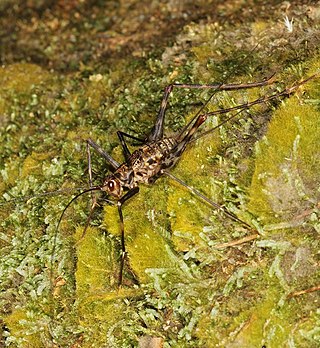
Phalangopsinae, occasionally known as spider crickets, are a subfamily of crickets in the family Phalangopsidae. Members of Phalangopsinae are found worldwide in tropical and subtropical regions. Most species in the subfamily are nocturnal and can be found in rocky areas, near fallen wood, and the understory of forests. Some species are gregarious, gathering in large numbers.
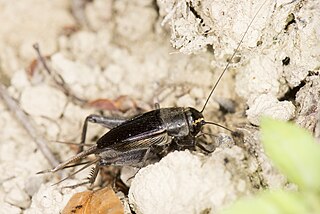
Teleogryllus is a genus of crickets in the family Gryllidae. Species can be found in Africa, Asia, Australia and the Pacific islands.

The Eneopterinae are a subfamily of crickets, in the family Gryllidae, based on the type genus Eneoptera. It is one of several groups widely described as "true crickets", but this subfamily may also referred to in American English as "bush crickets". Of the more than 500 species that make up this subfamily, most occur in moist, tropical habitats. These insects are medium to large and brown or gray in color. They eat plant leaves, flowers, and fruits and can occasionally cause economic damage. Their eggs are deposited in pith, bark, or wood. Eneopterinae show a great diversity in stridulatory apparatus, signals emitted, and associated behaviour.

Mogoplistidae is a family of scaly crickets and allies within the superfamily Grylloidea. Considered to be monophyletic, a sister taxon to the Gryllidae crickets. This family consists of more than 370 species worldwide; 20 species in 4 genera occur in North America and this family includes the scaly crickets of Europe.
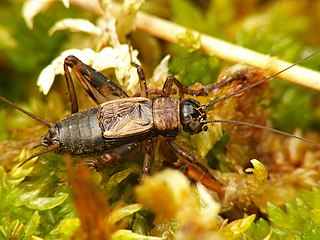
Nemobiinae is a subfamily of the newly constituted Trigonidiidae, one of the cricket families. The type genus is Nemobius, which includes the wood cricket, but members of this subfamily may also be known as ground crickets or "pygmy field crickets".

Bobilla is a genus of cricket in tribe Nemobiini, found in Australasia and the Pacific islands. These small black crickets sing using their wings and stridulatory files. Two species native to New Zealand are sympatric but can be differentiated by their song and the colour of their eggs.

Loxoblemmus is a genus of crickets in tribe Gryllini. Species can be found in Africa, Asia and Australia.

Podoscirtinae is a subfamily of crickets in the family Oecanthidae.

Trigonidium is a large genus of sword-tail crickets, typical of the tribe Trigonidiini. Records of occurrence are from Europe, Africa, tropical Asia, Australia and the Pacific islands; many species endemic to Pacific islands including Hawaii have now been placed in the genus Nudilla.
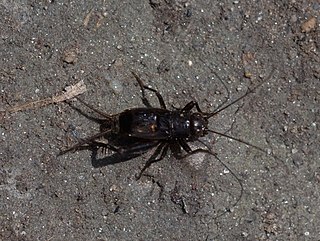
Pteronemobius is a genus of crickets in the subfamily Nemobiinae, with a worldwide distribution.

The Euscyrtinae are a subfamily of crickets, in the family Oecanthidae, based on the type genus Euscyrtus. They are terrestrial and omnivorous and can be found in: Central America, Africa, Asia and Australia.

Modicogryllini is a tribe of crickets in the family Gryllidae. Species are terrestrial, carnivorous or omnivorous and can be found in all continenents except Antarctica.
Xabea is a genus of crickets in the subfamily Oecanthinae and tribe Xabeini. Species can be found in Southeast Asia and Australia.
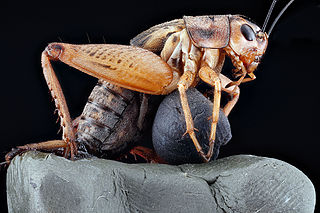
Velarifictorus is a genus of crickets in the family Gryllidae and tribe Gryllini. Species have been recorded in Australia, Asia, Africa and the southeastern US.
Aphonoides is a genus of crickets in the subfamily Podoscirtinae and tribe Aphonoidini. Most species records are from sub-Saharan Africa, Japan, eastern China, S.E. Asia and Australasia.

Ornebius is a genus of crickets in the family Mogoplistidae and the tribe Arachnocephalini, erected by Félix Édouard Guérin-Méneville in 1844. Species may be called "common scaled crickets" and have widespread records of distribution, which are discontinuous ; they include: Africa, Asia, Australia, islands in the Indian and Pacific Oceans, and South America.
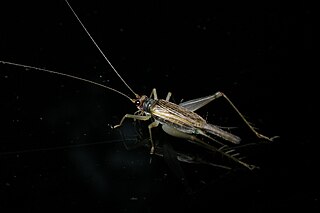
Amusurgus is a genus of Asian "sword-tail crickets", in the subfamily Trigonidiinae and the tribe Trigonidiini, erected by Carl Brunner von Wattenwyl in 1893. Species records exist for Pakistan through to Japan, South-East Asia through to Australia.

















